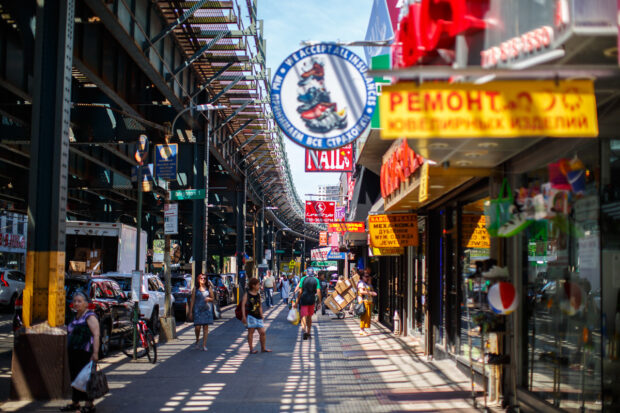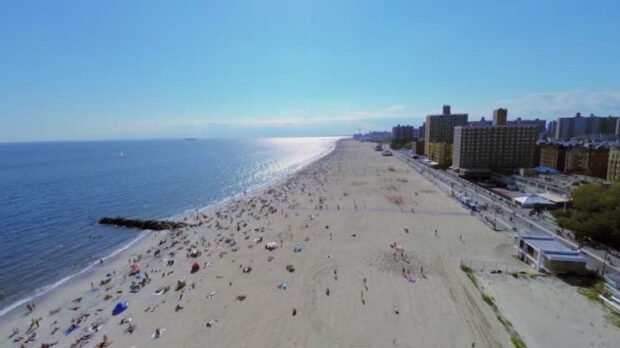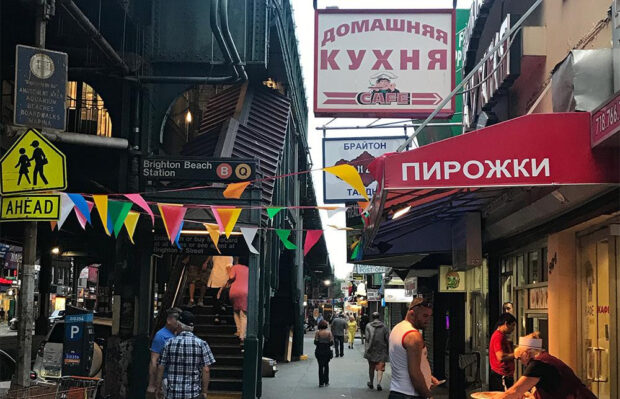
Brighton Beach is the heart of the Russian-speaking world of New York. Here you can meet representatives of all the former republics of the Soviet Union. The area received the nickname “Little Odessa” as a result of the unique colors created by the natives of this Black Sea city, and it is often called simply Brighton.
It is not common knowledge that due to its location on the luxurious Atlantic coast, the area was originally intended as a luxury resort. Located in Long Island’s southern Brooklyn Borough, Brighton Beach is once again attracting tourists with a vast gold strip of pure sand and warm ocean waters.
The history of Brighton Beach dates back to 1868 when it was designed as a Beaumont recreation area. Why Brighton? After laying a railroad branch and christening the place Brighton in honor of the popular British resort, the authorities built a chic hotel, baths, and a promenade.
The expectations were met: the richest Europeans did come here, and even the racetrack and casinos were built. At the turn of the century, it was the seat of the most brilliant society.
But life made its own adjustments. The Great Depression led to the decline of the resort area, hotels began renting out rooms for pennies every month, and low-income segments of society flooded in. The final end of Brighton as a resort came during World War II. In addition to poor Americans, many Europeans fled here to escape the oppression of fascists and Nazis. Many immigrants came from Vietnam, Pakistan, China, Mexico.
See also 45 Free Things to Do in New York City
The first wave of migration of the Russian-speaking population occurred in 1971 when the departure from the Soviet Union to Israel was allowed for family reunification.
Many of those who left the Soviet Union went to America. After leaving the USSR without money or any value, the Jews settled in Brighton, attracted by cheap housing for the poorest area of the city and its transportation accessibility.
The next wave of migration occurred during the Perestroika when people from the former Soviet republics came to the area. It was they who helped make the neighborhood one of the most colorful and unique corners of the city.
At this time, firms, cafes, educational and play centers in Russian began to appear. At present, Brighton Beach is developing from a poor and dangerous area into an attractive destination for non-standard tour travelers.

People in other parts of New York City are no longer so dismissive of this territory. At first, Brighton became a place of interest as a summer retreat. As time passed, houses and apartments became more expensive, and living here became more prestigious.
However, the unique atmosphere of the Soviet Union is still felt in the streets of the region. The place seems to have been preserved in the early 1990s, so different in appearance and behavior from Brightons to other parts of the city. Since 2010, Brighton Beach has been increasingly populated by Central Asian people who understand Russian.
According to various estimates, now the area is home to from 50 to 70 thousand inhabitants. In 2010, 23,500 people were officially living. It is difficult to establish the exact number since many do not participate in censuses or live illegally. The population consists of approximately equal numbers of women and men.
See also Shopping in New York: the Best Insiders Tips
Nearly three-quarters of the population is foreign-born, and only one-quarter was born in America. Russian-speaking Jews continue to be the main part of the population.
Brighton Beach is its own world inside New York City, speaking mainly in Russian. Despite the fact that many residents arrived 40 years ago, not everyone succeeded in mastering the language: more than a third of immigrants speak poorly or do not speak at all.

At best, a mixture of Russian and English is used, but more often just Russian or Ukrainian. In 2000, about 6% of Brooklyn’s population spoke Russian at home, according to the US Census Bureau.
Buildings in Brighton are quite variegated. Here you can find both single-story wooden bungalows and multi-story buildings in the style of the 20s. In the late 80s of the last century, Donald Trump’s firm organized the development of the area with social high-rise buildings. They were transferred to the state for a period of 40 years and then had to be released or redeemed. These complexes make the quarter look like the sleeping areas of provincial Russian cities during the Soviet era.
See also 10 World-Famous Paintings Exhibited in NYC
Between the Millennium Theater and the coast, there are mostly elite cottages of several floors belonging to show business stars, public figures, and other celebrities. At the beginning of this century, an expensive residential complex Oceana was erected on the ocean shore, in which Russian businessmen and high-ranking officials own apartments.
Like us on Facebook for more stories like this: